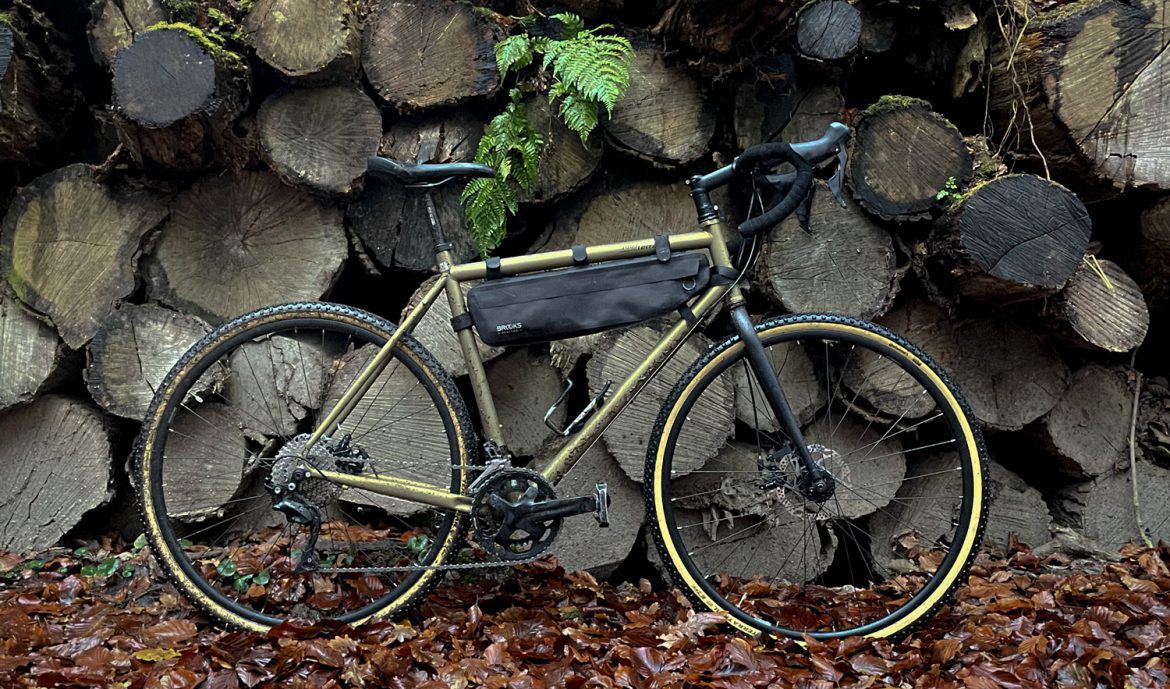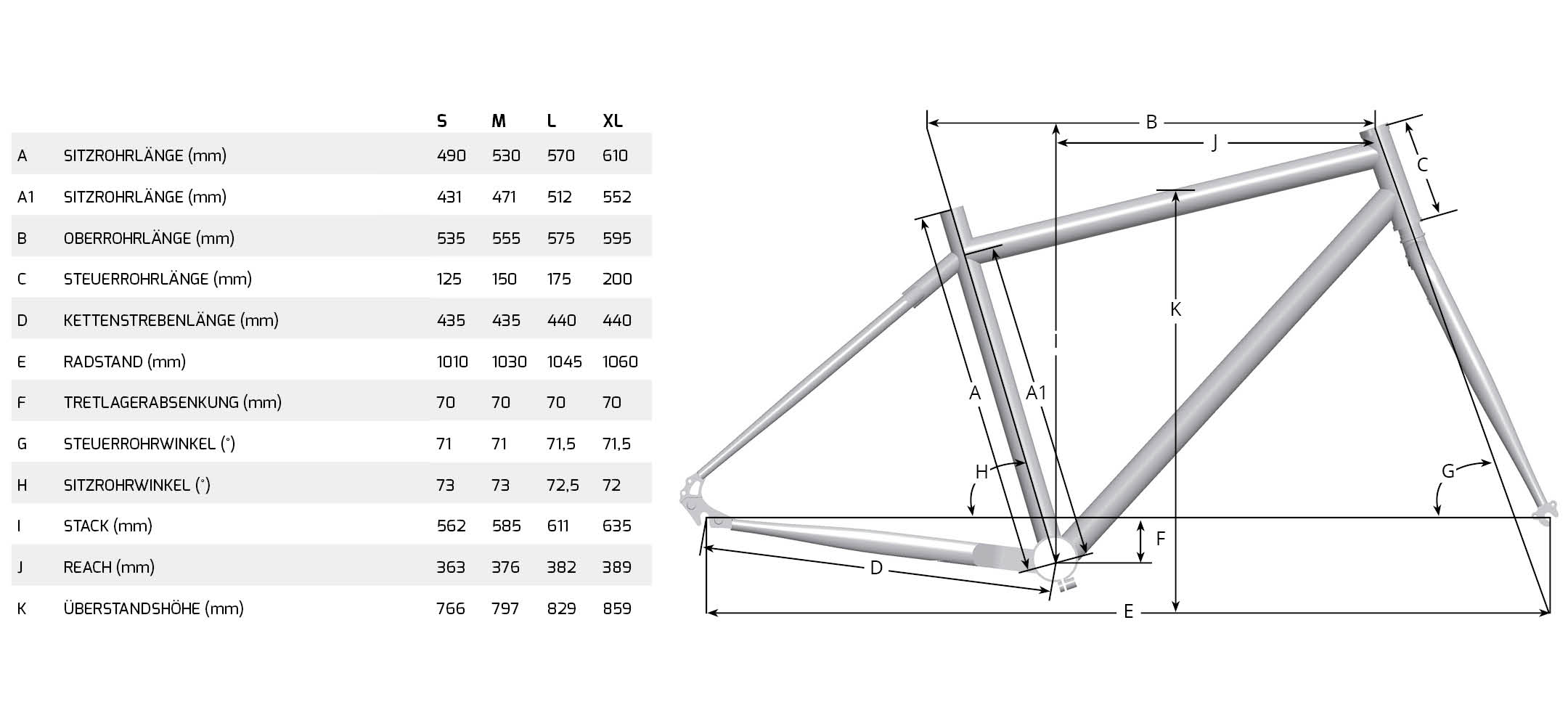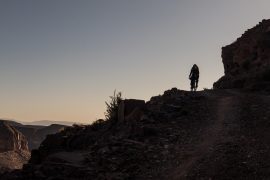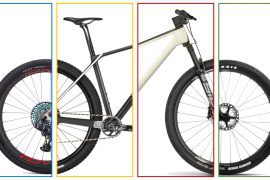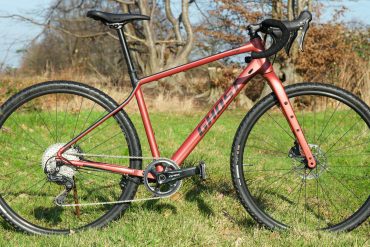Please note:
Tout Terrain provided me with a Vasco as a test bike at my request. This is advertising.I have to admit it right away: I am a Tout Terrain fan. That comes from my time when I did more classic bike tours around the world. My dream bike back then: the Tout Terrain Silkroad. It was everything I was looking for. A very good steel frame, integrated luggage rack, great gears, wheels & tyres in 26 inches for thousands of kilometres on all continents.
And this classic bike is still available today, modernised to 27.5 inches, with disc brakes and now also with Pinion gears.
For me, Tout Terrain stands for particularly robust and noble steel bikes from Freiburg, paired with a high level of knowledge of the challenges of a long bike trip. And with the advent of electronics on touring bikes and bikepacking, a kind of development lab was founded with Cinq, which focuses on the technical aspects and detailed solutions. This is where innovations such as The Plug USB charger, the Shift:R Road brake/shift levers for Pinion or the Cinq Touring and Adventure forks came into being.
A few years ago, Tout Terrain expanded its line-up and added the X.Over models to meet the growing demand for sporty and high-quality bikes for off-road adventures. These are mainly gravel bikes and MTBs with steel frames – many models with Pinion gearboxes as an alternative to the classic derailleurs.
My test bike, the Tout Terrain Vasco, also comes from this segment. The Vasco caught my eye two years ago and after Markus Stitz tested the bike on his Thuringia Tour, I wanted to take a closer look. At that time, Tout Terrain presented both the Vasco and the Scrambler Xplore as new gravel bikes. The Scrambler was introduced as a pure Pinion gravel version and was correspondingly more expensive. At around 1,900 euros, the Vasco was a very attractively priced steel gravel bike.
In the meantime, however, inflation and increased manufacturing costs have also had an impact and the “entry-level” Vasco now costs 2,700 euros. In my opinion, however, this is not too high a price, especially for a manufacturer that does not produce large quantities.
The name Vasco, however, does not come from Vasco da Gama, as I thought:
Vasco comes from the Spanish expression “país vasco” = Basque country.
The gravel bike is available in two versions: the GT 275 with 27.5 inch/650B tyres and the GT 28 with 28 inch/700cc tyres. In essence, the Vasco is able to accommodate both wheel sizes.
The maximum tyre width for 650B/27.5″ is 54mm and for 28″/700cc 47mm.
The Vasco was developed as an all-round gravel bike for asphalt adventures and off-road riding alike. The attachment points for bags and accessories also make the performance-oriented bike suitable for bikepacking tours.
In addition to the two Vasco “basic models”, there are also the Vasco Select models, which are sold as specialised trade models and are only available there.
In the GT 28 version there are four Select models (2.1, 2.2, 2.3 and 2.4), which differ mainly in their equipment. In the GT 275 model there is only one Select model (2.1).

I had the Vasco GT 28 Select 2.1 for testing. This bike has Shimano 105 2×11 gears, TRP Spyre mechanical disc brakes and is built more as a performance gravel bike than a gravel-travel version. I particularly like the colour called “Oliva Metallic Matt”. A simple, pleasant green that fits perfectly in the forest.
Due to the possibility of configuring your own personal Vasco in addition to the Select models, I will not so much evaluate the current component selection of the Vasco Select 2.1 in this review, but rather focus more on the frame/fork and the basic riding characteristics.
Frame and fork
The frame of the Vasco is made of 4130 chrome-molybdenum steel and the so-called Stratocrom tube set.
The Stratocrom tube set ideally combines weight, durability and riding characteristics.

According to my research, this butted tube set makes it possible to specifically take into account the load areas of the frame and to adapt the tube cross-section here. (If any of you have expertise in this area, please refer to me).
Our Stratocrom tube sets are designed by us together with our production companies for your bike. We consistently use high-quality CrMo 4130 (chrome-molybdenum) steel, which is butted (end-strengthened) once or twice. Thanks to the load-optimised tubes, which are individually selected for each model, we achieve a balance between weight and durability.
You can read about what conification means here. In addition, the tubeset is not particularly heavy, which is why the Vasco in the Select 2.1 version weighs “only” 12kg (11.9kg when reweighed). Yes, that may be a little heavier in our carbon and titanium world, but it is perfectly appropriate for a steel frame. In terms of weight, this puts the Vasco on a par with the Bombtrack Hook, the Böttcher Evolution, the Veloheld IconX, the Rondo Ruut ST1 or the Niner RLT 9.

However, weight-oriented gravel fans can still save weight in the configurator by choosing a carbon fork instead of the installed Tout Terrain Allroad Fork steel fork and a different gear. Alternative and above all better forks for bikepacking are either the Expedition Fork (also made of steel) or the Cinq Touring Fork II, both of which have enough eyelets for mounting holders, bags and carriers.
According to Tout Terrain, the steel frame comes as raw product from Vietnam. It weighs about 2,390g in size M (including primer and paint). According to Tout Terrain, the Allroad steel fork weighs 1,195g (with the steerer uncut). So in total it weighs about 3.6kg.
All further steps such as powder coating, assembly etc. are carried out at our factory.
It has enough eyelets and has a replaceable derailleur hanger. The frame is – from my interpretation – optimised for derailleur gears and specially designed to withstand the stresses of such gears.
Special frames for derailleur gears stand for optimised weight and uncompromising performance. This means that the conification of the frame, the cable routing as well as the braze-on parts are designed exclusively for the use of derailleur gears and thus no compromises have to be made. If derailleur gears are your gear of choice and you don’t need the option of converting to other types of drivetrains at a later date, then there is nothing better.
The gear and brake cables are on the outside of the Vasco – more classic. The brake mount on the fork and frame is flat-mounted, which is typical for gravel.

There are five eyelets below the top tube. These are intended for attaching frame bags or for routing a rear light cable. Or to attach a holder for an air pump or bottle cage. Unfortunately, there are no attachment points for a cockpit bag on the top tube. The Vasco also has mounting options for two bottle cages in the frame triangle and one on the down tube. However, you have to pay attention to the routing of the Bowden cables.
In addition, a luggage rack and mudguards can be mounted. The corresponding eyelets are standardised for M6. You might have to apply a little more pressure the first time, however, as the eyelets can be blocked by the paintwork.
All this makes the Vasco a good all-rounder and a good bike for fast rides on gravel or as a bikepacking machine.
The official system weight is 120kg. But I asked about this again, because the steel frame should actually be able to withstand more:
This is the system weight that results from the requirements of the ISO 4210 test standard. Anything above that has to be tested in a non-standardised test specially developed by the testing laboratory (in consultation with the manufacturer). For our touring bike frames we also test beyond the standard, for our gravel bike we do not consider this necessary. Nevertheless, we are confident about the durability of the frame (even if the system weight is exceeded).
A special feature of the frame is the steering stop, called Ergo-Stop II. This consists of corresponding stops on the head tube and a counterpart on the fork tube. This limits accidental damage to shift or brake cables and the frame when the front wheel is turned over.

The steering angle is thus limited to 78 degrees (on both sides) and provides sufficient freedom of movement. The steering stop is fixed in the Vasco frame, so it cannot be deselected. If it bothers you, you can at least replace the Ergo-Stop clamp with a standard 10mm spacer.
A word about the paintwork: I rode the test bike with a frame bag and many bikes show signs of wear in the paintwork after a short time. Not so with the Vasco, where the paint is very resistant. Tout Terrain calls this powder coating T-Coat. But I would still mask it off.
Geometry and handling characteristics
Tout Terrain describes the geometry of the Vasco as Performance Gravel Geometry.
The frame is agile on tarmac and goes the extra mile on gravel roads.

The Vasco does not ride softly and has good power transmission. I had to get used to it and was initially sceptical about how the bike would behave off-road. On asphalt, it performs well and rolls very well. When you turn onto gravel and forest highways, it really goes the extra mile and rolls off the line. In a direct comparison, I found the Rose Backroad more agile off-road than the Vasco. On the other hand, riding the Tout Terrain was as pleasant as riding the Ritchey Outback or the Böttcher Evolution.
The Vasco’s steering is nicely direct, but without disturbing the smoothness of the ride. The propulsion is sporty and was quite sufficient for me. Subjectively, however, I would not classify the Vasco as a performance gravel bike. In any case, it is a sporty bike for gravel.
But when it becomes more trail-heavy, I find the Vasco not so suitable. That certainly also has to do with the tyre choice and size. And when it’s wet or muddy, the Vasco reaches its limits with the Terra Trail at 700cc x 40mm. Even when accelerating, the rear wheel slipped several times.

With more width or 27.5 inch tyres, this might be different. However, the Vasco doesn’t have to go on the trails. In my opinion, it’s not really built for that. It is simply a great gravel bike for “normal” and sporty fun on gravel, in the forest and on asphalt.

One reason for the Vasco’s good rolling behaviour may be the longer wheelbase, the distance between front and rear wheel (axle to axle) of 1,045mm (in size L). For comparison: the Veloheld IconX has a slightly shorter wheelbase of 1.043mm. The Bombtrack Hook is even shorter at 1.027mm. The Böttcher Evolution (+37mm) and the Ritchey Outback (+24.6mm) have longer wheelbases.

Short chainstays allow the bike to accelerate rapidly, while the generous lowering of the bottom bracket lowers the centre of gravity for excellent stability.
The chainstays are already short at 440mm (in size L). Competitors like the Bombtrack Hook, Niner RTL 9 and Rose Backroad have even shorter ones. In comparison, the Backroad is also a little more agile. The Vasco, on the other hand, is a bit smoother off-road, which I also like.
The Böttcher Evolution and the Ritchey Outback have longer stays. I would compare both bikes with the Tout Terrain Vasco in terms of ride feel and characteristics.

The moderate frame reach gives you a comfortable riding position for long days in the saddle without compromising foot clearance and handling at low speeds.
The reach on the Vasco in size L is 382mm and the stack is 611mm.
For better understanding:
- Reach describes the vertical distance from the centre of the bottom bracket to the top of the head tube.
- Stack describes the horizontal distance from the centre of the bottom bracket to the top of the head tube.
A lot of stack and little reach means: The frame is slightly shorter and you sit more upright.
Little stack and a lot of reach mean: The frame is longer and you sit more stretched/athletic on the bike.
What is interesting, though, is the ratio of stack to reach. This value (Stack-to-Reach Ratio) is 1.6:1 on the Vasco. Translated, this means: you sit quite upright and comfortable on the Vasco, which is good for long rides.

From a StR ratio of 1.55, one speaks of such a comfortable seating position. The Salsa Fargo, by the way, has a StR ratio of 1.74, which is why it is an endurance couch. Comparable to the Vasco would be the Böttcher Evolution, which has a ratio of 1.58.
From 1.45 to 1.55 one speaks of a rather sporty seating position. This is where all the bikes I have listed here fall in comparatively. The Rose Backroad with 1.49, the Niner RLT 9 with 1.55, the Bombtrack Hook with 1.5 and the Ritchey Outback with 1.51.
Below 1.45, you can assume a very sporty, race-oriented riding position.
My Vasco in the Tout Terrain configurator
As I already said: the equipment variants and options for the Vasco are very diverse and should offer something for almost every taste. Only SRAM is used (not yet), but Tout Terrain also sells the Vasco as a frameset for self-building. Simply select Frame Set derailleur in the configurator.

The test Vasco in the Select 2.1 configuration has a 2×11 Shimano 105 road bike gear system and with a gear ratio of 46/30 at the front and 11-34 at the rear, it doesn’t really have an off-road bandwidth if you want to go into the mountains with luggage. For sporty graveling, however, you are sufficiently equipped here. However, I would always prefer a GRX on a gravel bike.
The brakes are mechanical TRP Spyre. I rode them at the Atlas Mountain Race and Tobias also used them at the Silk Road Mountain Race. Well engaged and adjusted, the Spyre brakes are pretty good and crisp. On the test bike they still had to be braked in. Those who are used to hydraulic brakes will notice the difference to mechanical brakes. Among other things, you have to start braking a little earlier.

The wheels were Ryde Andra 321 aluminium rims with 40mm Continental Terra Trail tyres. I found the rims ok, but they are not tubeless compatible. In the meantime, Tout Terrain has switched to DT-Swiss G540 rims, which I also find better.
My experience with the tyres was rather bad. Together with inner tubes they were not convincing. After just a few kilometres I had a flat tyre. And then another one. In the end, I just put in a new inner tube and that was that. But since tubes are fortunately no longer a serious option and tubeless is gaining ground, that was probably just an exception. The Terra Trail are certainly good tyres for dry weather. On my test kilometres, they were not convincing and often slipped away, especially at the rear when accelerating or sportily approaching a curve.

The hubs on the test bike are Tout Terrain’s own, with a Centerlock disc mount. And with thru axles. Front 12x100mm and rear 12x142mm.
But now I want to configure my own Vasco:
I’ll choose British Racing Green as the colour. But there are also all kinds of customisation options. The fork I’m using is of course the Carbon Touring Fork II with lots of eyelets. I can take a lot of luggage with me and it is much lighter than the steel fork.
A derailleur is mandatory. Unfortunately, you can only choose between the Campa Ekar 1×13 or a frame set derailleur. This means only the frame set, without gears. According to Tout Terrain, however, the Shimano GRX variants will soon be available in the configurator.
So I treat myself to the Italians from Campa and stroll on to the lighting. Since I mainly want to ride the Vasco on tours, I choose the SON hub dynamo and Plug6 USB charger kit.

For the handlebars, I opt for the Tout Terrain Longhorn comfort handlebars, which offer a flare of 35 degrees. The handlebar on the test bike was a normal drop bar, which was also too narrow for me. Of course, this changes the comfort of a ride considerably. When it comes to the headset, I don’t mess around and go for Chris King. Expensive, but good.
In the luggage carrier options, I can choose carriers for the rear, front and for the fork. I’ll leave that out, because I’d ride the Vasco with the Ortlieb Quick Rack and the Fork Packs.
For the wheels, I can only choose the colour of the hub (black) and only have one option for the tyres: Vredestein Aventura 44mm. According to Tout Terrain, these are supposed to offer more grip off-road with 44mm width and the slightly rougher tread. I assume that the configurator does not yet work very well for the Vasco. So if in doubt, call Freiburg or send an email.
I quickly chose the Brooks Cambium C-15 saddle and the in-house Micro-Adjust seatpost and my personal Vasco is ready.
5,513 euros are on the bill. I can order right away, but they tell me that it can take up to 6 months until the bike is ready.
When I check out, I am offered Ortlieb bicycle bags for the configured Vasco. However, classic bike bags and not the more suitable bikepacking bags from Heilsbronn. But even that is only a question of the right configuration of the configurator.

Without the configurator, however, my choice would probably fall on the Vasco GT 28 Select 2.3 with Touring Fork II carbon fork and Shimano GRX 1×11 gears.
Conclusion & classification in Martin’s all-road bike categorisation
As you know, I have developed an all-road bike categorisation in which I classify all the bikes I test and thus create a little more clarity.
This is not easy, also because the variety of types, applications, categorisations and trend names make it almost impossible to structure it. Nevertheless, I have given it a try. I have created three categories under the umbrella term “all-road bike”, which of course overlap and thus also have things in common:

- Performance & Race: Some of the bikes come from the racing bike/crosser sector and/or are inspired by it. Especially racing cyclists who switch to gravel find pleasure in these very sporty bikes, which are primarily intended for competitive use.
- Leisure & everyday life: Here I see the bikes that combine the sporty and the relaxed and with which you can go almost anywhere without thinking much about it. Yes, here we are mainly talking about the classic gravel bike as a great offer to all those who don’t want to worry about the ground anymore, but just want to ride.
- Travel & Adventure: Yes, even the daily commute to work can be an adventure, but in this category I see all bikes that are suitable for almost all terrains, whose roots lie more in MTB and that make off-road, bikepacking and bike travel possible in all variations.
For me, the Tout Terrain Vasco sits in the sweet spot between Performance&Race and Travel&Adventure. It can be a sports machine in the forest, but I see its strengths more in sporty bikepacking to bike touring.
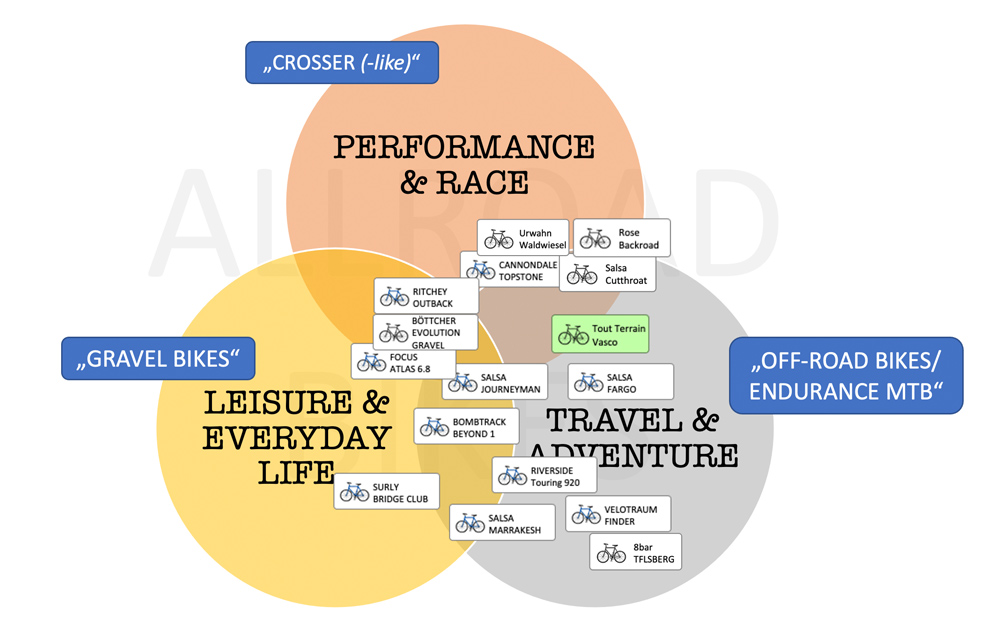
The Vasco, as described above, is a very pleasant bike for riding on asphalt and in the forest. It’s a lot of fun to ride. However, I would change the tyres, as they limit the Vasco’s possibilities too much. On the road and off-road, the Vasco rolls very well and has good propulsion, even if there are faster and more agile gravel bikes.
The smoothness is very pleasant and the power transmission very good (the frame is hard). The Vasco is not a zippy bike, but once it gets going it is agile enough to cope with most challenges on gravel and forest highways. It’s only on trails and blocked sections that I wouldn’t see it. Maybe it’s different with the Vasco 275.

But I see the Vasco as much more than just a gravel bike. For me, it is interesting above all as a “new type” of touring bike. Gravel bikes – apart from the performance-oriented models – are, in my view, ideal for continuing the success story of the first touring bikes – the Randonneurs.
The Tout Terrain Vasco has everything for this: a geometry for the long haul and many hours in the saddle, enough mounting options for racks and luggage, with sporty travelling in the foreground (fans of the heavy-load faction should still stick to the Silkroad), sufficient tyre width for the world’s tracks and rim sizes to be better prepared for a lot of terrain.

With a choice of 1-speed and 2-speed gears, there should also be enough bandwidth and capacity to get up hills well with luggage. A hub dynamo and USB charger provide all the options for mounting lights and charging devices on the road. I discussed the system weight limit of 120kg above. In any case, there is enough space and limit for luggage even for larger tours.
In this sense, the Vasco can be your gravel bike at home for sport and small tours. And it can also be your travel bike when you want to go out for longer and spend several days and weeks on the bike.
And if you still have any doubts, you should take a look at the story of Dan and René, who cycle from Freiburg to Bangkok. Dan rides this tour on a Vasco. René uses the Tanami, which I also tested years ago.

